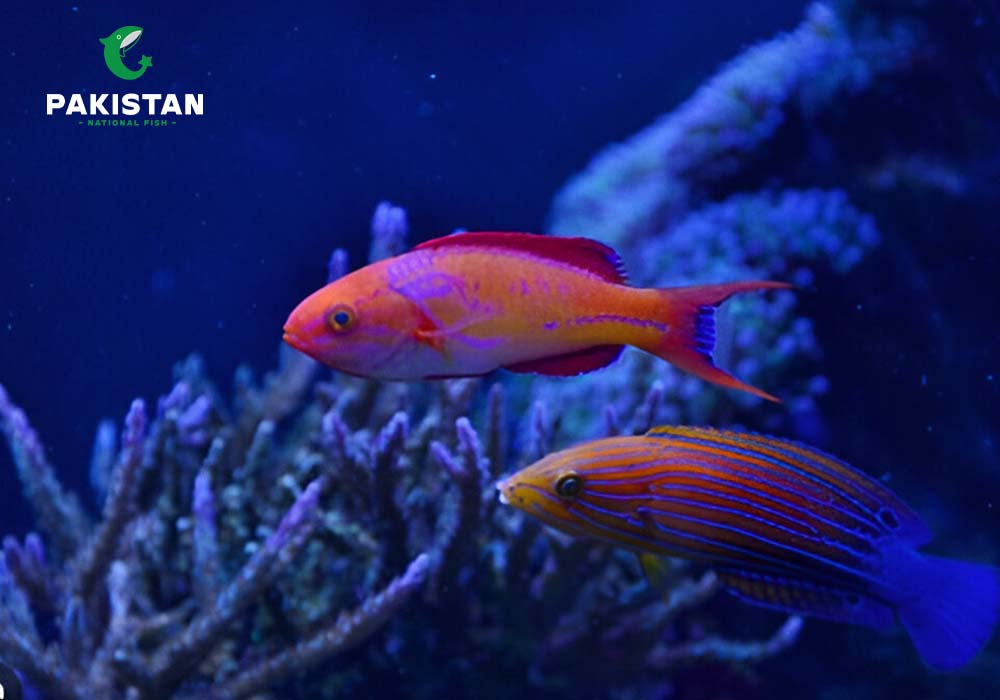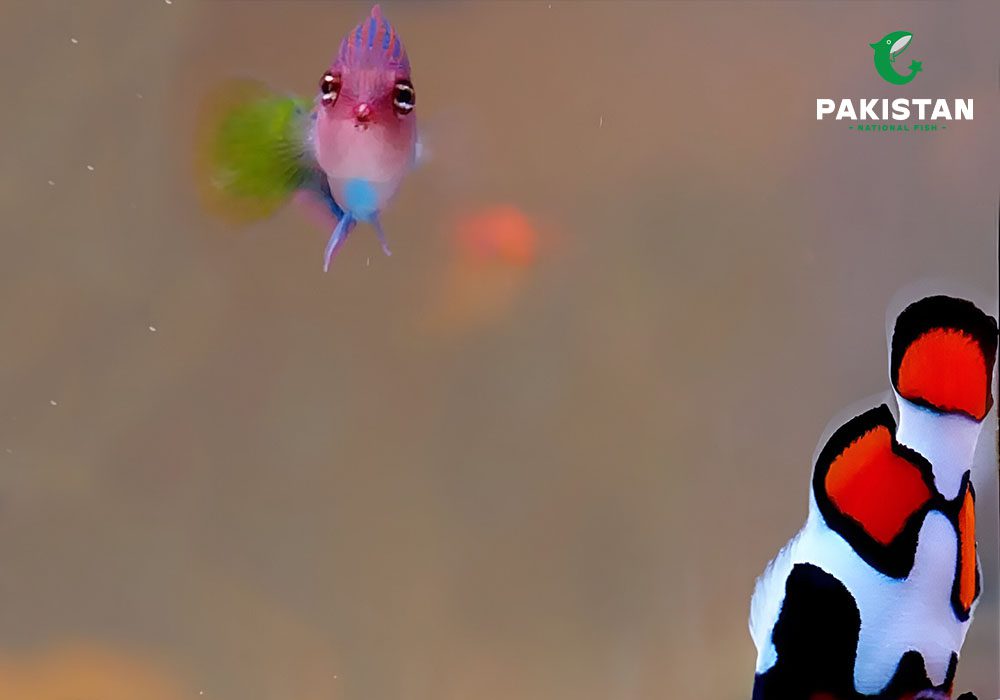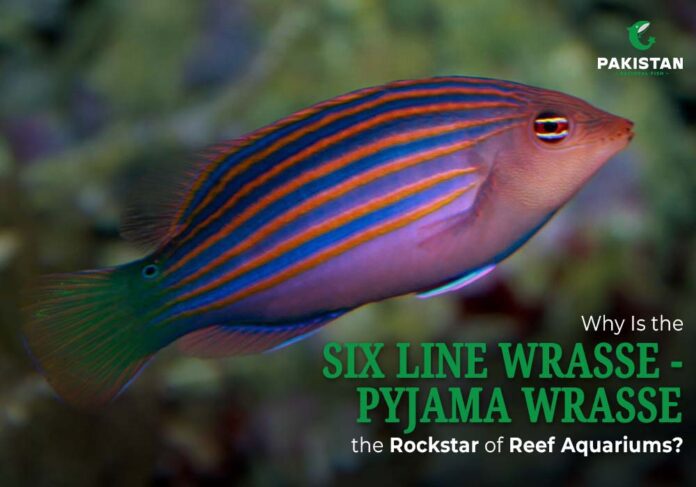Dive into the vibrant world of the six line wrasse, a dazzling little fish that’s like the Tuna Fish of personality in your reef tank—small but packed with pizzazz! Known for its striking colors and energetic antics, this fish, scientifically named Pseudocheilinus hexataenia, is a favorite among aquarists. Whether you call it the 6 striped wrasse, coral wrasse, or pyjama wrasse, this Indo-Pacific gem brings life to any aquarium. But how do you keep this feisty fish thriving?
Keep reading to find out everything you need to know about the six line wrasse and keeping this colorful fish in your own aquarium!
QUICK FACTS ABOUT THE SIX LINE WRASSE
Scientific Name | Pseudocheilinus hexataenia (Synonyms: Cheilinus hexataenia, Cossyphus echis, Pseudocheilinus psittaculus, Pseudolabrus hexataenia) |
Common Names | Six Line Wrasse, 6 Striped Wrasse, Pyjama Wrasse, Coral Wrasse |
Distribution | Indo-Pacific (Red Sea to Central Pacific, including Japan, Australia, and Micronesia) |
Maximum Size | 7.5 cm (3 inches) |
Temperature | Tropical: 23-27°C (73-80°F) |
Water Parameters | Specific Gravity: 1.020-1.025, pH: 8.1-8.4 |
Compatibility | Reef with caution |
Lighting | No special requirements |
Reef Aquarium Compatibility | Excellent, but large specimens may eat ornamental shrimp |
Sexual Dimorphism | No obvious external differences; protogynous sequential hermaphrodites |
What Makes the Six Line Wrasse So Special?
Picture a fish that’s like a living rainbow darting through your tank. The Sixline / Pajama wrasse, or Pseudocheilinus hexataenia, is a showstopper with its bluish-purple body, six bold orange stripes, and a green tail with a cheeky “false eye” to fool predators. Its red eyes, accented with white stripes, give it a mischievous charm. This fish isn’t just a pretty face—it’s a pest-eating machine, gobbling up nuisances like flatworms and pyramidellid snails. It’s like having a tiny, colorful janitor for your reef tank!
- Vibrant Colors: The 6 striped wrasse’s orange lines pop against its blue body, making it a focal point in any aquarium.
- Pest Control: It hunts small invertebrates like bristle worms, keeping your tank clean.
- Active Personality: Always on the move, it weaves through rocks and corals, adding energy to your setup.
But here’s the catch: while it’s a dream for many aquarists, its feisty nature requires some know-how to keep everyone in the tank happy. Let’s dive deeper!
Where Does the Six Line Wrasse Come From?
The six line wrasse calls the Indo-Pacific home, thriving in coral reefs from the Red Sea to Micronesia, Japan, and Australia’s Great Barrier Reef. These fish love shallow waters, usually no deeper than 100 feet, where they can dart into coral crevices for safety. Their natural habitat is a clue to their needs in captivity—plenty of hiding spots and a vibrant, reef-like environment.
- Geographic Range: Found from the Red Sea to the Central Pacific, including New South Wales and northwestern Australia.
- Habitat Preference: They favor coral reefs and rocky crevices with ample hiding places.
- Depth: Typically found in waters up to 35 meters deep, where they can stay close to protective cover.
How Big Does a Six Line Wrasse Get?
Don’t let their small size fool you—these fish pack a big personality into a compact package. The six line wrasse grows to about 3 inches (7.5 cm) in length, making it perfect for smaller aquariums. At fish stores, you’ll often see them in the 1-2 inch range, but they’ll reach their full size within a year or two with proper care.
- Maximum Size: 3 inches (7.5 cm).
- Growth Rate: Juveniles grow quickly, reaching adult size in 1-2 years.
- Tank Size: A minimum of 30 gallons is recommended, though 55 gallons is ideal for their active swimming.
Their small stature makes them a great fit for nano reefs, but they need space to zip around and explore.
What Are the Ideal Tank Conditions for a Six Line Wrasse?
To keep your pyjama wrasse thriving, you need to mimic its natural reef environment. This means stable water parameters, plenty of hiding spots, and a tank setup that lets it feel secure. Here’s how to set up the perfect home:
- Tank Size: At least 30 gallons, but 55 gallons or more is better for their active nature.
- Water Parameters: Maintain a specific gravity of 1.020-1.025, pH of 8.1-8.4, and temperature between 23-27°C (73-80°F).
- Live Rock: Provide plenty of live rock with caves and crevices for hiding and foraging.
- Lighting: No special lighting is needed, but moderate lighting mimics their natural reef habitat.
- Lid: These fish are jumpers, so a tight-fitting lid is a must to prevent escapes.
Pro tip: Arrange your live rock to create natural hiding spots. This not only keeps your wrasse stress-free but also encourages its natural behavior of darting in and out of crevices.
Is the Six Line Wrasse Reef Safe?
“Is the pyjama wrasse reef safe?” you ask. The answer is a cautious “yes.” The six line wrasse is generally considered reef safe, meaning it won’t munch on your corals or clams. However, it’s a carnivore with a taste for small invertebrates, so ornamental shrimp and small crabs might be at risk, especially as the fish grows.
- Coral Safety: They don’t eat corals but may stress them by picking at tiny invertebrates living among the coral tissue.
- Invertebrate Risk: Larger specimens may snack on ornamental shrimp or small crabs.
- Pest Control: They’re excellent at eating pests like flatworms, bristle worms, and pyramidellid snails, making them a valuable addition to a reef tank.
Research shows that about 80% of aquarists report no issues with reef safety, but 13% note challenges with corals due to the wrasse’s foraging behavior. Keep an eye on your tank and feed them well to minimize any trouble.
How Do You Feed a Six Line Wrasse?
These little hunters are carnivores with a big appetite. In the wild, they spend their days picking at live rock for small crustaceans, worms, and zooplankton. In your tank, you’ll need to provide a varied, protein-rich diet to keep them healthy and happy.
- Diet: Offer meaty foods like mysis shrimp, brine shrimp, and finely chopped seafood. They’ll also accept high-quality flakes and pellets.
- Feeding Frequency: Feed 2-3 times daily in small portions to match their active metabolism.
- Tip: Spread food around the tank to reduce competition and aggression, especially in community tanks.
- Live Rock Bonus: A tank with plenty of live rock provides natural grazing opportunities, reducing the need for supplemental feeding.
Fun fact: If your tank has a healthy microfauna population, your wrasse might not need as much extra food, as it’ll happily hunt copepods and isopods all day long.
Do Six Line Wrasses Get Along with Other Fish?

Compatible Tank Mates:
- Ocellaris Clownfish (Amphiprion ocellaris)
- Sailfin Tang (Zebrasoma velifer)
- Longnose Hawkfish
- Other peaceful fish with different body shapes
Avoid These:
- Other blennies (unless in a large tank with a mated pair)
- Gobies or dartfish in small setups
- Aggressive fish like Tessalata Eels or Blue Spotted Puffers
Some aquarists report their wrasse living harmoniously with clownfish and gobies, while others have seen them chase smaller fish like pseudochromis. Monitor new additions closely to ensure peace.
Are Six Line Wrasses Aggressive?
“Are wrasse fish aggressive?” The six line wrasse has a reputation for being a bit of a wildcard. While not outright vicious, it can be territorial, especially in smaller tanks or with similar-looking fish. Their behavior varies—some are model citizens, while others play the role of tank tyrant.
- Aggression Triggers: Small tanks, lack of food, or similar-shaped fish can spark territorial behavior.
- Mitigation: Add them last, ensure ample hiding spots, and feed frequently to keep them content.
- Personality Variation: About 60% of aquarists recommend them, but 20% report issues with aggression, especially toward new tank mates.
Can You Keep a Six Line Wrasse with Clownfish?

Wrasse and clownfish can make a great pair, but it’s not a guaranteed love story. The six line wrasse and clownfish often coexist peacefully, especially if the tank is large enough and the wrasse is introduced after the clownfish. However, the wrasse’s feisty nature can sometimes lead to chasing or nipping, particularly if the clownfish is smaller.
- Tank Setup: A 55-gallon or larger tank with plenty of hiding spots helps reduce tension.
- Introduction Order: Add the wrasse last to let the clownfish establish territory.
- Observation: Watch for signs of aggression, like chasing or fin-nipping, and be ready to intervene if needed.
What’s the Deal with Their Sleep Cocoon?
One of the coolest quirks of the six line wrasse is its bedtime routine. At night, it wedges itself into a crevice and spins a mucus cocoon to sleep in, like a tiny aquatic sleeping bag. This cocoon is thought to mask its scent from predators, keeping it safe while it snoozes.
- Purpose: The cocoon protects against nocturnal predators and may reduce stress.
- Cleanup: The wrasse often eats the cocoon upon waking, but you might spot it floating in the tank.
- Tank Tip: Ensure plenty of crevices for sleeping to mimic their natural behavior.
How to Introduce a Six Line Wrasse to Your Tank?
Bringing a six line wrasse home is exciting, but they’re notorious for being poor shippers, so proper acclimation is key. Here’s how to set them up for success:
- Quarantine: Keep them in a quarantine tank for 2-4 weeks to monitor for diseases and ensure they’re eating.
- Acclimation: Slowly drip-acclimate over 4 hours to adjust to your tank’s water parameters.
- Introduction: Use an acclimation box if your tank already has fish to prevent immediate territorial disputes.
- Timing: Add them at night with dim lights to reduce stress and aggression from other fish.
Curious Queries About the Six Line Wrasse
Conclusion: Stay Tuned for More Reef Adventures
The six line wrasse is a vibrant, pest-eating powerhouse that can light up your reef tank—if you’re ready for its spirited personality. By providing the right tank setup, diet, and tank mates, you’ll have a thriving coral wrasse that’s the envy of every aquarist. But the reef world is full of wonders!
Stay tuned for our next blog, where we’ll dive into the dazzling world of clownfish and their anemone homes. Want to know how to pair them perfectly? Keep your eyes on this space!


